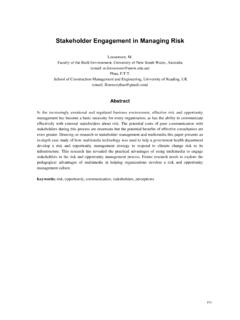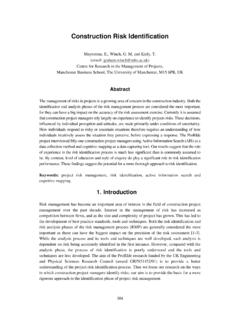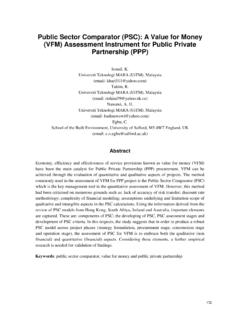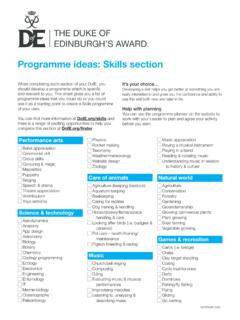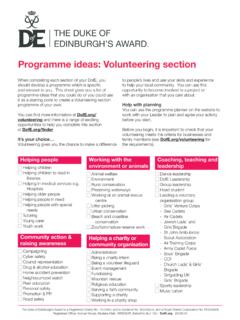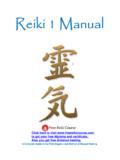Transcription of Sustainable Design and Feng Shui: A Case Study of an ...
1 Sustainable Design and feng shui : A Case Study of an Office Building in Sydney Mak, School of Architecture and Built Environment, The University of Newcastle, Australia (email: Ge, School of the Built Environment, University of Technology, Sydney, Australia (email: Abstract Interactions between humans and environments are a part of an everyday process. In the western contemporary architecture, these interactions with the natural and man-made environment called Sustainable or Green Design . In the East, the ancient Chinese knowledge of feng shui aims at creating a harmony between environment, buildings and people.))
2 It has influenced most traditional building Design in China for thousands of years. With a desire to improve the relationship between human and the environment, there is an increasing interest for architects and other building professionals to apply the concepts of feng shui into building Design and the built environment. It is suggested that interpreting feng shui knowledge would embrace the western concept of Sustainable Design . This paper analyzes and compares the concepts of Sustainable Design with feng shui . A case Study of a well recognized Sustainable designed office building, Workplace6 in Sydney is used to illustrate the similarities and differences between concepts of Sustainable Design and feng shui in terms of environmental Design .
3 The findings indicated that both Sustainable Design and feng shui concepts are aimed at the creation of the enjoyable space and balance between natural and the built environment. However, Sustainable Design focused on the measurement and performance of physical attributes, whereas feng shui concepts emphasized on the balance and harmony of physical forms and spatial arrangement which are difficult to be measured and quantified. Keywords: Sustainable Design , feng shui , green star, Workplace6 831. Introduction Sustainable Design is the philosophy of Design the built environment to comply with the principles of economic, social and ecological sustainability (McLennan, 2004).
4 Sustainable Design emphasizes on a holistic approach to eliminate negative environmental impact through skillful and sensitive Design . The goal of Sustainable Design is to look at all the systems together and to make sure they work in harmony. This integrative Design process is similar to the Chinese holistic view and the feng shui approach to the built environment (Humphreys, 1976). feng shui is a body of ancient Chinese wisdom in knowledge and experience related to the built environment that has been accumulated for more than three thousand years. The principles and practices of feng shui aimed at creating a harmonised built environment for people to live in, and it represents a traditional Chinese architectural theory for selecting favourable sites as well as a theory for designing cities and buildings (Lee, 1986).
5 There are two main schools of thought and practice in feng shui : the Compass School and the Form School. The Form School approach has been well recognized and widely accepted by feng shui researchers as comprising the scientific bases in the analysis of built environment (He, 1990; Cheng and Kong, 1993). The Form school established a holistic approach that allows integrated components and elements to be considered for the built environment (Mak and Ng, 2008). Since the late 1960 s the impact of western civilisation and technology has grown to global proportions, more western scholars became aware of the limitations of the modern scientific paradigms that failed to explain the whole realm of natural phenomena and began to recognize that there are similarities between modern science and eastern philosophy (Capra, 1975).
6 Joseph Needham (1959), in his book series Science and Civilisation in China began to appreciate the value of feng shui in ecology and landscape aesthetics. According to Needham (1959, ) feng shui embodied .. a marked aesthetic component, which accounts for the great beauty of the siting of so many farms, houses and villages throughout China . Kevin Lynch, a pioneer of environmental behaviour research, in his book, The Image of the City , concluded that feng shui is an open-ended analysis of the environment where new meanings, new poetry, and further developments are always possible (Lynch, 1960).
7 Anderson and Anderson (1973) recognized that feng shui is an aspect of Chinese cultural ecology, and called feng shui the traditional Chinese science of site planning , containing an organized body of knowledge, intensely practiced in application, and of specific intent (Anderson, 1973, ). Furthermore, Freedman (1979) accepted that feng shui is based on self-evident propositions and the expertise of scientific men and called it mystical ecology . Nemeth (1993) recognized that cosmographic interpretations of geomancy maps can both teach Western peoples and remind East Asians that in the organization of human activities in physical space, principles that engender productive economic, ecological, and ethical relationships may be governed by a natural law (Nemeth, 1993, ).
8 Bruun (1995) suggested that feng shui is a system of statements on the man-84nature relationship in an environment of holistic thought, and man and landscape are linked together in a system of immanent order . Nowadays, as many researchers seek to establish a deeper understanding of these relationships between the human and natural environments, architects and building professionals begin to recognize feng shui as a broad ecologically and architecturally connected paradigm. Hwangbo (1999) believed that the practice of feng shui is an intuitive matter involving site selection and spatial organization, and it has strong parallels with the western concept of geometry in architectural Design .
9 This paper explores the relationships between the concepts of Sustainable Design and feng shui in environmental Design using a case Study of an office building in Sydney. Firstly, a set of five concepts of Sustainable Design and five feng shui concepts in terms of environmental Design are identified and compared. Hence, a well recognized Sustainable designed office building, Workplace6 in Sydney is used as a case Study to illustrate the similarities and differences between the concepts of Sustainable Design and feng shui environmental Design . 2. Comparison of Sustainable Design and feng shui The Sustainable Design includes many areas such as waste and recycling, energy, water, building Design , emission, indoor environmental quality (IEQ), alternative transport, landscaping, and about everything that do affects everything around human, aims to eliminate negative environmental impact and maintain ecologically Sustainable completely through skillful and sensitive Design (McLennan, 2004).
10 Many of these ecological Sustainable Design concepts are quite similar to the traditional views that were derived from the eastern philosophy and feng shui principles and practice. Dong and Zuehl (2009) recognized that there is a set of five fundamental concepts for Sustainable development. They are constructivism, circular Design , energy efficiency, balance between natural and the built environment, and thinking global and buying local. These five fundamental concepts are then compared with the five feng shui concepts in terms of environmental Design . Sustainable Design concepts (1) Constructivism: Sustainable Design is based on studies from constructivism (an approach to cognitive psychology and social psychology) to create spaces that built knowledge and skills for the end user.



